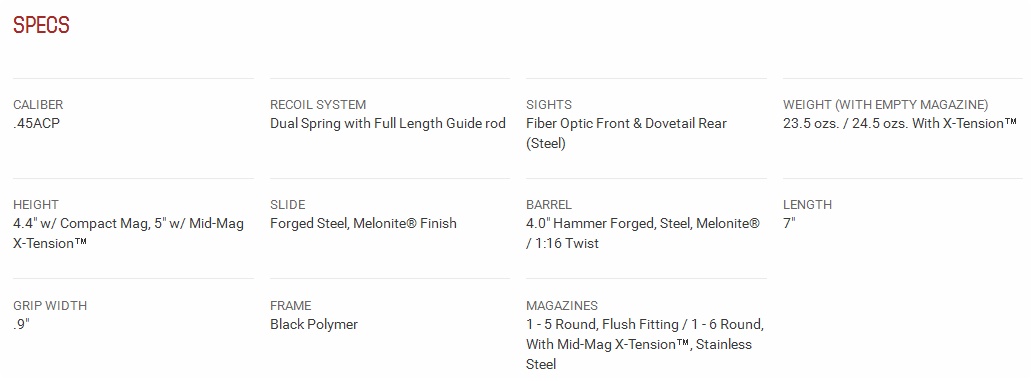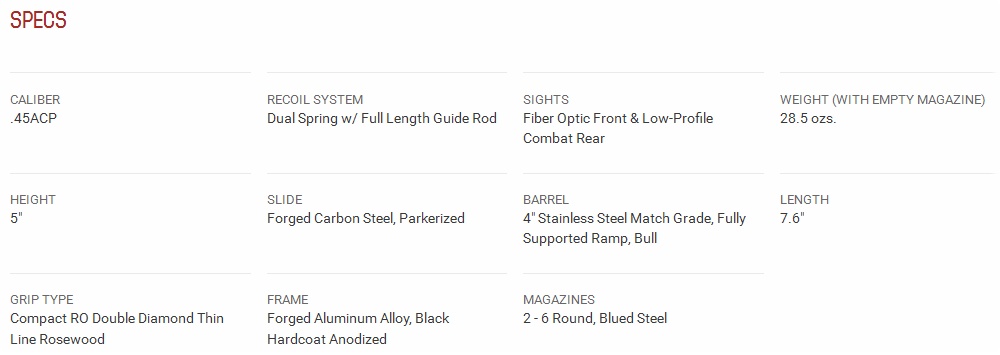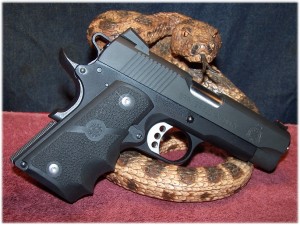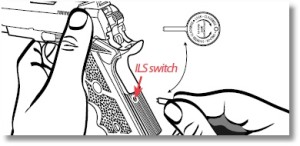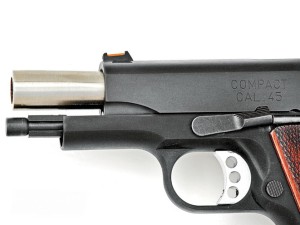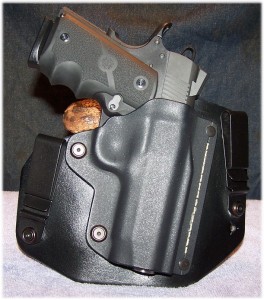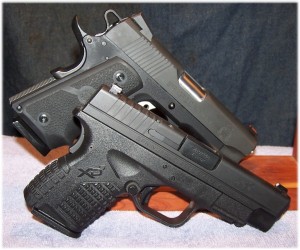 The beauty of compact pistols is that they can be carried as a primary counter-offensive firearm or as a backup to a primary counter-offensive firearm. The XDs 4.0 45 and Springfield Range Officer Compact could serve both roles equally well, although they are diametrically-opposed platforms.
The beauty of compact pistols is that they can be carried as a primary counter-offensive firearm or as a backup to a primary counter-offensive firearm. The XDs 4.0 45 and Springfield Range Officer Compact could serve both roles equally well, although they are diametrically-opposed platforms.
The purpose of this comparison is not to recommend one over the other, but simply to present the facts about each pistol and let the reader decide for themselves which platform is more to their liking. Both pistols exude quality and it is simply a matter of whether you prefer a polymer-framed, striker-fired pistol or a forged composite aluminum, hammer-fired pistol. Note that both pistols are available in 9mm (at the time of this writing, the XDs is also available in .40 Smith and Wesson), although the comparison versions are in .45 ACP simply because I own them both in .45 ACP.
Note: For simplicity sake, and the fact that both pistols are Springfield Armory products, the Springfield XDs 4.0 45 is referred to as the XDS 4.0 45 and the Springfield Range Officer Compact is referred to as the ROC.
THE BASIC SPECIFICATIONS:
XDs 4.0 45:
ROC:
STYLING:
XDs 4.0 45:
The Springfield XDs 4.0 45 has “forward” styling, for lack of a better term. The style reflects the current polymer popularity while leaning toward a design that would apply to future firearms. The beauty of polymer-frame pistols is that manufacturers can do quite a lot to enhance (or destroy) the appeal of the firearm.
ROC:
The Springfield ROC follows the same styling as most 1911-based pistols with modern anointments. With the 1911 platform, there is only so much you can do to enhance the styling of the original design without bending toward the ludicrous. The Springfield ROC is cleanly fashioned and exhibits the qualities that most 1911-based pistols now desire.
MODERN MANUFACTURING:
XDs 4.0 45:
A Forged Steel, Melonite® Finish slide houses a 4.0″ Hammer Forged, Steel, Melonite® / 1:16 Twist barrel and glides over a black polymer, highly-textured frame. Also housed within the slide is a Dual Spring with Full Length Guide rod. The XDs 4.0 45 is also available with a Forged Stainless Steel slide. Overall, the manufacturing of this pistol is excellent.
ROC:
The ROC list of features includes a Parkerized, forged carbon steel slide that is mated to a Parkerized, forged aluminum alloy frame. A “Match Grade” fully supported ramped 4.0” bull barrel makes an impressive statement about the pistol. Of course, MIM parts are used where needed. Overall, the manufacturing of this pistol is excellent.
SIGHTING SYSTEM:
XDs 4.0 45:
The XDs 4.0 45 incorporates a Fiber Front & Dovetail Rear (Steel) sight system. Exchangeable (replacement) fiber colors are also available with the pistol.
On my particular XDs 4.0 45, the front sight worked loose the first day of firing. I replaced the sights with Trijicon night sights as this pistol was to be my EDC – at least at times.
ROC:
The ROC incorporates a Fiber Front sight (with exchangeable fiber colors) & Low-Profile Combat Rear with two-dots. The rear sight is not adjustable except through drifting. If this pistol is to be my EDC, I’ll have night sights installed. The type is not yet determined.
FRAME AND SLIDE:
XDs 4.0 45:
 My particular XDS 4.0 45 has the Forged Steel, Melonite® Finish slide. It blends well with the polymer frame. While I prefer a stainless steel slide for the hot and humid Southern summer months, the black slide helps with concealing the pistol due to my wearing of predominantly black t-shirts throughout the year.
My particular XDS 4.0 45 has the Forged Steel, Melonite® Finish slide. It blends well with the polymer frame. While I prefer a stainless steel slide for the hot and humid Southern summer months, the black slide helps with concealing the pistol due to my wearing of predominantly black t-shirts throughout the year.
The slide is nicely fitted to the highly-textured frame. The slide serrations are aggressive but yet are beveled somewhat so as not to disagree with the hand when using them. The slide, at the muzzle end, is nicely beveled to allow easy insertion into a holster.
The XDs 4.0 45 comes with two grip adapters that can be quickly changed out to fit your particular hand size. Two magazine sleeves for the Mid-Mag X-Tension™, Stainless Steel magazine allow for the blending of the magazine base to the grip adapter configuration.
The frame incorporates a rail up front for mounting a light or laser (or both in a combination). The frame is also highly textured in the side and front of the grip area. The interchangeable grip adapters are also highly textured. Some feel, as I do, that the grip area is “too textured” and is rough on the hands. However, when shooting this pistol, the texturing comes in handy in managing the recoil of this little beast.
Also, the grip area is lightly relieved and provides a nice recessed area in which to rest the thumb and also allow easy access to the magazine release button on either side. The rear of the grip has a nice up-swept beaver-tail that allows you to get your shooting hand as high on the back-strap as possible while preventing slide bite.
ROC:
The Forged Carbon Steel, Parkerized slide and Forged Aluminum Alloy, Black Hardcoat Anodized frame are well matched and mated. Usually, when a slide and frame of different materials and finishes are united, there is some difference in appearance. Springfield has done an excellent job of blending both fit and finish with the usual culprits of Slide Lock, Plunger Tube, Thumb Safety, and beaver-tail grip safety being slightly different. The Slide Stop and Plunger Tube are pretty well matched with a semi-glossy appearance. The thumb safety is a flat finish (Parkerized?) with the grip safety being somewhere in between the Slide Stop/Plunger Tube and Thumb Safety. The Mainspring Housing is matte finished checkered polymer. The hammer, another MIM component, is finished somewhere in between everything. Stark contrast to everything is provided by the aluminum trigger. Semi-glossy grip screws against the nice and thin, cross-cannon grip panels add another contrast. Overall, the appearance of the pistol somewhat takes away from the true quality of the pistol. As with the RIA CSU, the pistol has somewhat of a “Frankenstein” look to it.
I have, with my particular ROC, opted to replace the grip panels with the Hogue Rubber Wraparound Grip with Finger Grooves (Officer Model sizing) and chose to attach it with Hogue stainless steel screws. While the rubber Hogue grip blends well with the frame and slide, the use of stainless steel grip mounting screws add a bit of contrast, as does the aluminum trigger and exposed muzzle. I find the contrast appealing – at least to me.
One thing that is noticeable is that the base of the internal extractor protrudes slightly from the end of the slide and the difference in treatment in the extractor and the slide is evident. If you are used to a flush-fitting extractor, it might bother you. Not to worry your self about it; the extractor works just fine, thank you.
The grip is of the M1911 design, which means that the mainspring housing. Is flat However, the mainspring housing can be changed to a round style like that found on the M1911A1 or even a mainspring housing/magwell after-market unit. The grip, as is, is sufficient for most hands.
The front strap is smooth and devoid of serrations or checkering. With the Hogue grip, the fingers have a place to rest and the grip is very positive.
SAFETIES:
XDs 4.0 45:
The XDs 4.0 45 utilizes the popular “trigger-flapper” that dictates a positive trigger finger position on the trigger in order to fire the pistol; the trigger cannot be pulled if the trigger safety has not been pressed.
Additionally, a grip safety is incorporated into back strap of the pistol that necessitates that the operator has a correct grip on the pistol in order for it to fire.
The XDs 4.0 45 also incorporates an external “chambered round” indicator on the top of the slide that serves as a tactile and visual indication of the chamber condition (loaded or empty).
There is also an internal safety that prevents the pistol from firing should it be dropped onto a hard surface.
There is no external thumb safety.
ROC:
As with the RIA CSU, the ROC follows the “70 Series” pistol and has no hammer block safety, but does incorporate the “Safety Notch” in the hammer. The thumb safety on the ROC is extended and is left-side only. While I prefer an ambidextrous safety, I have no issue with a 1911-based pistol that does not incorporate one. I have learned to run the safety with my weak hand (left). The thumb safety is extended and is very positive in operation from one mode to the other. When new, the thumb safety is stiff, but I would rather have one that way. Although stiff, it is equally stiff in both directions, which indicates that the safety was properly set up at the factory.
The thumb safety lever has a more than adequate thumb surface and is nicely curved to accommodate the thumb when it is moving the safety lever in either direction.
As with the RIA CSU, the ROC utilizes the beaver-tail grip safety as standard fare and incorporates the memory bump for positive operation. It is fitted very nicely to the grip. Nothing to brag about here as it works as intended.
The ROC incorporates a locking safety in the Main Spring Housing that requires a special key (provided) to engage and disengage. In short, don’t lose the special key. When in the locked position, the pistol’s action is completely inoperative. I have heard of some replacing the Springfield Main Spring Housing with a Main Spring Housing that does not incorporate the safety device. I would not recommend this in a pistol that is intended for carry due to liability issues should that pistol is ever used in a self-defense situation. Removing a factory safety is a no-no. I have every intention of leaving it as it is.
INTERNALS:
XDs 4.0 45:
Inside the slide is well-finished as is the frame. Positive locking slots capture the barrel locking lugs. The frame rails mate nicely with the slide and with a dose of Mil Spec grease, the slide to frame movement is excellent with no signs of high spots in either.
ROC:
Internally, the ROC is finished well with nary a tool mark showing.
The 4.0-inch barrel incorporates the usual swing link, but also incorporates an integral feed ramp that is nicely finished. A barrel-integrated feed ramp, in my opinion is favorable over a frame-integrated feed ramp – especially when the frame is an aluminum alloy as is the ROC. Early lightweight “Commander” and “Officer” models of other manufacturer’s 1911-based pistols suffered feed ramp damage from aggressive hollow point ammunition against aluminum frames much to the consternation of their owners. Ruger opted for a titanium insert into the aluminum frame to counter any damage; whereas, Springfield utilizes the barrel-integrated feed ramp.
There are just some pistols that feel very smooth when feeding over others. The ROC is one of those pistols. Cycling the slide is like buttering bread with soft butter. I use Mil-Spec grease on all of my 1911-based pistols where slide meet the frame. The ROC sings like a bird when you rack the slide and there are no signs of interruption when doing so
MAGAZINES:
XDs 4.0 45:
The XDs 4.0 45 comes with 1 – 5 Round, Flush Fitting and 1 – 6 Round, With Mid-Mag X-Tension™, Stainless Steel magazine. Additionally, the pistol ships with a choice of magazine bases that can be swapped out fairly easy; one base is a flush-fit base (my preference) while the other base allows the operator to rest the little finger against a rest (instead of hanging free or gripping the bottom of the magazine).
The magazine release button is ambidextrous and is easily reached.
ROC:
The ROC is shipped with two 6-round flush fitting magazines. I used both magazines during range time with the pistol and have no complaints. Any aftermarket 1911-based 7-round and above magazine will also work in the Springfield ROC. In fact, I would advise on using Wilson Combat 7-round magazines with bumper pads as they look good, they provide a 7+1 capacity, and with the shorter grip frame enhance concealment.
The magazine release button is left-side only and is easily reached.
VISUAL IMPACT:
XDs 4.0 45:
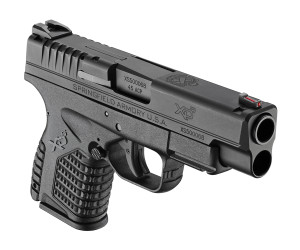 The XDs 4.0 45 has a “forward” look to it with the 4.0” barrel. Unloaded it is slightly barrel heavy, but once loaded it is nicely balanced and is actually a visually appealing pistol. The pistol says that it is here for business and the large bore confirms that fact. While the Springfield XDs 4.0 45 may appear cluttered to some, it is a nicely streamlined pistol. Especially appealing is the thin 0.9” grip.
The XDs 4.0 45 has a “forward” look to it with the 4.0” barrel. Unloaded it is slightly barrel heavy, but once loaded it is nicely balanced and is actually a visually appealing pistol. The pistol says that it is here for business and the large bore confirms that fact. While the Springfield XDs 4.0 45 may appear cluttered to some, it is a nicely streamlined pistol. Especially appealing is the thin 0.9” grip.
The slide and frame, of course, is busy with many indicators such as model, origin of manufacture, manufacturer, and serial number on the external side of the chamber a the ejection port and underneath the frame within the rail. Additional markings are on each side of the grip area that identifies the model and Springfield locations. Additionally, information is contained on the base of the flush fit magazine as to what it is intended to house. All in all, the pistol makes for a good source of reading material (with an unloaded pistol, of course) if you don’t know what is being held in the hand.
ROC:
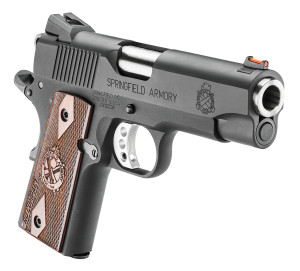 The ROC is, as with the XDs 4.0 45, a “business class” of pistol with nice grip panels. The visual impact of a small pistol with a big hole in the end of it says that if the bad guy is going to play he is also going to pay. The 1911 design is naturally different from that found on pistols like the XDs and others. The visual appeal of the 1911 is what draws many to it – and perhaps curiosity about the 1911 platform.
The ROC is, as with the XDs 4.0 45, a “business class” of pistol with nice grip panels. The visual impact of a small pistol with a big hole in the end of it says that if the bad guy is going to play he is also going to pay. The 1911 design is naturally different from that found on pistols like the XDs and others. The visual appeal of the 1911 is what draws many to it – and perhaps curiosity about the 1911 platform.
You know that it is a compact pistol, because COMPACT CAL .45 is laser etched on the left side of the slide. The right side of the slide incorporate a laser etched SPRINGFIELD ARMORY and a laser-etched Springfield Armory logo of crossed cannons. Just above the trigger guard on the right side of the frame you discover where Springfield Armory is located and also the serial number of the pistol.
The visual impact of a 1911-based pistol is timeless and when chambered in .45 ACP – priceless.
DISASSEMBLY AND RE-ASSEMBLY:
When it comes down to it, both pistols are easy to disassemble (field strip), and it can be done without tools. The ROC; however, is more complex in its disassembly and assembly than the XDs 4.0 45. However, both have their quirks.
XDs 4.0 45:
Disassembly:
- After ensuring that the pistol is unloaded and safe, insert an empty magazine.
- Pull the slide to the rear to lock it into place.
- Visually inspect the chamber to confirm that the pistol is not loaded.
- Rotate the disassembly lever clock wise to a vertical 12 o’clock position. Note that the disassembly lever cannot be rotated unless the magazine has been removed.
- Pull the slide slightly to the rear until the slide stop disengages from the slide.
- Firmly gripping slide, allow the slide to slowly move forward until the spring tension is released.
- While holding the slide, pull the trigger with the firearm pointed in a safe direction to fully unlock the slide from the frame. !IMPORTANT!
The trigger will not reset or release at this point but will remain in the most rearward position. If you move the trigger forward, you cannot reassemble the pistol. - Do not retract and release the striker allowing it to snap forward as this can damage the striker pin safety.
- Move the complete slide assembly forward and off of the frame.
- Remove the recoil system from the slide.
- Remove the barrel from the slide by lifting it up from the rear of the barrel and out from the rear of the slide.
Reassembly:
- Install the barrel into the slide while ensuring that the top of the chamber is flush with the top of the slide.
- Install the recoil system and ensure that it is properly aligned and rested in its notch on the barrel.
- Install the slide assembly onto the frame while making sure that the trigger is in the rearward position.
- Move the slide to its most rearward position (spring tension will be encountered) and move the slide stop up to lock the slide in place.
- Rotate the disassembly lever counter-clockwise to the normal (locked) position.
- Pull the slide rearward to unlock it and slowly allow the slide to move forward into battery.
- Insert an empty magazine and perform a function check.
ROC:
Springfield Armory provides a FLGR plastic “keeper” to secure the FLGR when disassembling and re-assembling the slide and frame. The ROC can be disassemble and reassembled with or without the “Keeper.” However, the “keeper” is really needed when the pistol is new.
There are two ways to remove the slide from the frame:
Disassembly Method #1:
The slide is first pushed to the rear to engage the Slide Stop with the Slide Stop Notch in the slide. The “keeper” is pushed into place on the Guide Rod and keeps the guide rod from returning into the slide. The slide is then removed in the normal fashion with the slide stop aligned with the correct notch in the slide, the Slide Stop removed from the frame, and the slide pulled forward off of the frame.
Once the slide is removed from the frame, the Guide Rod assembly, now a captive unit is removed from the slide to the rear of the slide. The barrel is then removed from the front of the slide
Disassembly Method #2:
Move the slide to line up the disassembly/assembly notch with the Slide Stop. Hold the Slide and Frame in this position and remove the Slide Stop (Note that the slide is under tremendous spring tension at this point). Slowly allow the Slide to move forward until no spring tension is felt. Then, remove the slide from the frame. The Guide Rod and Recoil Springs will rest against the Barrel Swing Link Housing.
The ROC uses a dual recoil spring arrangement. Once the slide is removed from the frame, the dual springs, FLGR, and FLGR bushing can be removed after making it a “unit” by pushing the FLGR to the front of the slide until you can press the plastic “keeper” in place on the guide rod. The FLGR “unit” is then removed from the rear of the slide. The barrel is removed from the front of the slide as usual.
Guide Rod Disassembly:
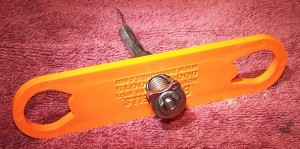
Modified Barrel Bushing Wrench Makes Disassmbling and Assembling the “Captive” Guide Rod Assembly Easy
To totally clean the FLGR, it must be disassembled. I have modified a standard barrel bushing wrench to disassemble (and assemble) the FLGR on the Rock Island Armory MS and CS pistols and it also works with the FLGR assembly in the ROC, although the guide rod bushing on the ROC is just slightly smaller in the base that the RIA units. It still; however, works by compressing (while pointing the FLGR unit in a safe direction (I like using a rolled up towel in front of the unit just in case) the dual springs until the plastic “keeper” can be removed from the guide rod. Then, I slowly allow the bushing to go forward until no spring tension is felt and then remove the bushing from the assembly.
The FLGR incorporates dual springs; one on the guide rod itself, and a second that is isolated from the first by an outer shell. The outer spring and shell can be removed to clean and lubricate the inner spring and guide rod. The inner spring and guide rod is a single unit. Once the FLGR components are cleaned and properly lubed, they are reassembled and then the FLGR assembly is once again compressed with the modified barrel bushing wrench, the “keeper’ put in place, and spring tension is released by removing the modified bushing wrench. Once again, the FLGR is a unit.
Slide to Frame Assembly:
- Install the barrel as usual.
- Insert the GLFR bushing into its normal position in the slide from the rear. Leave the “Keeper” in place on the FLGR unit. Also, ensure that the Guide Rod is positioned to fit properly against the barrel (the indention on the base of the Guide Rod, fits around the barrel).
- Insert the slide into the frame. Locate the swing link and install the Slide Lock enough to capture the barrel to the frame.
- Locate the disassembly/assembly notch in the slide and push the Slide Lock into place.
- Press the slide to the rear and push the slide lock into the locking notch in the slide. This compresses the FLGR springs.
- Remove the “keeper” from the FLGR unit.
- Press the Slide rearward slightly and press the Slide Lock down to clear the Slide.
- Hold the slide and then slowly allow the slide to go forward into battery.
- Perform a function check and you are ready to go.
THE FINAL CHOICE:
Obviously, the final choice between the Springfield XDs 4.0 45 and the Springfield Range Officer Compact is yours, as is the choice of having neither of them.
Springfield XDs 4.0 45 and the Springfield Range Officer Compact are totally opposite each other with the exception of caliber and in calibers of 9mm and .45ACP (and now in .40 Smith and Wesson for the XDs) it is only your preference that matters.
HOW THEY CARRY:
XDs 4.4 45:
From the holster, I can’t detect any slowness of speed getting the 4.0 version on target as compared to the 3.3 version. My holster for both guns is the IWB holster from SHTF Gear (see https://guntoters.com/blog/2014/06/02/xds-45-iwb-holster-by-shtf-gear/ for a review of this holster). The muzzle of the 3.3 version is even with the bottom opening of the Kydex shell; whereas, the muzzle of the 4.0 version protrudes just a bit more. The fiber front sight of the 3.3 version is within the Kydex shell; whereas the front sight of the 4.0 version is not protected by the Kydex shell. No matter, both versions are equally at home in the SHTF Gear IWB holster.
Of course, like its little brother, the 4.0 version is a single-stack that can utilize a 5-round or 7-round magazine. Some may say that is a drawback of such pistols. The gun is carried with the 5-round magazine and I normally carry two, 5-round magazines in IWB magazine carriers for spares.
The XDs 4.0 45 is a winner and a keeper for me. As Springfield puts it, “Choosing a handgun for concealed carry doesn’t have to be a series of compromises anymore. You don’t have to settle for a larger gun to gain shooting comfort. Nor do you have to sacrifice features for power. And you certainly don’t have to carry a gun to the store that you’d rather not carry to the range. Put an XD-S® Single Stack in your hand today, and you’ll want to shoot it. Put it in your holster, and you’ll find that it’s Noticeably Unnoticeable™.”
ROC:
Weighing in at 28.5 ounces (1.78 pounds) unloaded; the ROC is a joy to carry. As a comparison, the Ruger SR1911CMD-A weighs in at 29.3 ounces (1.83 pounds) dry and the RIA CSU weighs in at a whopping 37.6 ounces (2.35 pounds) unloaded.
With a barrel length of 4.0 inches, the ROC can be carried in anything that can house a “Commander” or “Government” length 1911-based pistol (for full muzzle protection) and any open-bottom holster like a Crossbreed Super Tuck Deluxe. The Springfield ROC feels right at home in my modified ACE-1 Gen 2 Holster by SHTF Gear that was intended for the Ruger SR1911CMD. As you may or may not know, I modified my ACE-1 Gen 2 Holster by removing the sweat shield; a feature that I do not like with a 1911-based pistol. The ACE-1 Gen 2 Holster houses any “Commander” length 1911- based pistols and also a shorter barrel length pistol like the RIA CSU with equal aplomb. Read my review of the ACE-1 Gen 2 holster for the “Commander” at https://guntoters.com/blog/2015/09/05/shtf-gear-holster-1911-commander/
With a short grip area, the ROC pulls right into my side just where I like it and printing while bending over is greatly reduced over the longer grip length of “Commander” and “Government” pistols.
Of course, “Cocked and Locked” Condition 1 is the order of the day with a 1911-based pistol. I have full confidence in the Springfield ROC not to go “boom” if I accidentally press the trigger with the thumb safety in the “on” position, unlike some pistols that incorporate a “safety” within the trigger. Just sayin’!
RANGE TIME:
XDs 4.0 45:
The XDs 4.0 45 performs exceptionally well. There have been several hundred rounds thrown through this pistol without a single failure except on my part. The pistol has performed flawlessly and is more accurate than I am.
As light as this pistol is, recoil is very manageable if I do my part. With this pistol; however, I have to wear shooting gloves for comfort when shooting full defense loads through it; the grip texture can take its toll on the hand. Since I normally wear shooting gloves anyway, with few exceptions, it is not a big deal.
The trigger is not bad and not good at the same time. And, I do say that with a slight bias. However, a good trigger is a good trigger and the XDs 4.0 45 has a nice trigger. It exhibits a little take up, a little “spongy feel”, and then a clean break with a quick reset. I actually like that “spongy feel” just before the break, as it allows me to back off the trigger if need be.
A striker-fired pistol’s trigger is a striker-fired pistol’s trigger with few variants. It is actually unfair to compare them to a non-striker fired pistol, because their trigger characteristics are entirely different. I have problems with the Glock trigger over the Springfield trigger, and the Ruger SR series of pistol triggers fall somewhere in between. They are what they are and with enough trigger time I can adapt to any trigger.
With indoor range lighting, the sights are hard for me to pick up. In daylight, they are marvelous. Unfortunately, they did not stay on the pistol long enough for me to really evaluate them; they were exchanged for a set of Trijicon Night Sights after the front sight decided to start walking on me off the slide.
The XDS 4.0 45 worked well with all ammunition being fed through it. On some days, it seemed to favor 185-grain fodder and other days 230-grain ammunition was better. In either case (no pun intended), the pistol shot better than I could.
ROC:
It really does not take an immense quantity of ammunition to gauge the success, or lack of, in a firearm.
I had plenty of 230-grain FMJ ammunition on hand, but I wanted also to see how the Springfield ROC fared with 185-grain FMJ – to begin with. So, with 50-rounds of each, off to the range we go.
So, to what does one compare a lightweight, compact 1911-based pistol in .45 ACP to? Since I was used to shooting my Ruger SR1911CMD-A, which weighs only slightly more than the Springfield ROC and has a barrel length of only .25-inches more that the Springfield ROC, I had a good source for comparison. There is also the Springfield XDs 4.0 45, which is a smaller pistol (holding only 5-rounds in a polymer-framed, striker-fired pistol) and weighs only 23.5 ounces (about 1.5 pounds) unloaded, which is lighter than the Springfield ROC although the barrel is the same length. Between the SR1911CMD-A and the Springfield XDs 4.0 45, I felt that I had a good foundation for comparison.
I decided to use only the magazines that came with the Springfield ROC and loaded each with only five rounds – to break in the magazines. I had two standard silhouette targets; one to be used with 50-rounds of 230-grain (810fps) FMJ range loads from Georgia Arms, and one for 50-rounds of 185-grain FMJ (900fps). Both targets were set up at a distance of 10-yards. Rounds were to be shot using a modified Weaver and unsupported. I was testing for function more than grouping, but I would try to attempt the best group possible with the ammunition used.
Granted that the ammunition selected is not indicative of full-powered defensive loads, but the reason for using them was to simply check form and function. After all, I was breaking this thing in, alright!
First of all, I expected the ROC to be “snappy” in recoil and muzzle flip to be, well, uplifting. I had already exchanged the thin grip panels with the Hogue Rubber Wraparound grip with finger groove to get a better purchase on the pistol and reduce the felt recoil a tad. There was not going to be any double-taps, running drills, or magazine dumps – just slow firing to see how well the ROC and I work out compatibility issues. As it turned out, there were none to speak of.
How bad does the Springfield ROC recoil? Not as much as I thought it would. Perhaps, it’s the design of the pistol with a different grip setup, but the recoil is manageable and not all that much different from that of the Ruger SR1911CMD-A and Springfield XDs 4.0 45. That is easy for me to state, of course, because I have fired both of these pistols. I was pleasantly surprised with the Springfield ROC, and gladly so, because it has been accepted into the family and I have to live with my decision in accepting it. It’s really not a hard decision to live with.
One hundred rounds were chosen and one hundred rounds were shot without a failure. When I fire the gun, it just seems that it is a solid piece of work; it speaks of quality with every shot. What started out as a form and function check ended up being a fun session with my trying to hit different points on the target. Go for some head shots, go for a right shoulder shot, see if I could place a few rounds in that left kidney – that sort of thing. Where I aimed the ROC, and if I did my part, I could hit pretty darn close to what I was aiming at. That pleased me very much.
For my old eyes, the sights on the Springfield ROC are hard to pick up in the lighting at the indoor range. Outside in daylight, the sights were very clear and the red fiber optic sight up front really stood out. I will say that if I continue on with this gun and carry it for EDC, I would seriously consider outlaying the expense of putting a good set of Trijicon Night Sights on it.However, in normal lighting conditions, the sights are adequate for defensive use.
The trigger is crisp and right at about 4.5 pound of pull. There is a little take-up, a wall (tension against the sear), and then boom once the wall is passed (the sear releases). There is no other trigger like that found on the 1911, with the exception of a single-action revolver, in my humble opinion.
All in all, it was a very fine day for me and the Springfield ROC.
THE FINAL WORD:
Personal pistol preference is, well, personal preference. As I stated at the beginning of this article, I am not here to tell you what to buy. What I hope to accomplish is to provide more information about the Springfield XDs 4.0 45 and the Springfield ROC than you would find with other write-ups on these two pistols and put this information together as a single unit.
Both pistols are quality pistols and I have no qualms about carrying either one of them as my primary carry or as a back-up to full size pistols in each genre.
I have had positive compliments made regarding both of these pistols from others. While I do cherish positive comments, the one that I cherish the most is what comes out of a bad guy’s mouth when he is confronted with either of these pistols. If, “Oh, S…!” is heard, that is a very positive comment.
In all honesty, I did not intend to own these two pistols. I had purchased the Springfield XDs 3.3 45 and about a week later the 4.0 45 hit the shelves. It had to come home with me, because I like a 4” barreled handgun.
The ROC was also a strange case. I like an “officer” size 1911, but I like the “Commander” size even more. The Springfield ROC is a combination of both and that appealed to me.
While I openly admit a preference toward the 1911 platform, striker-fired pistols also have their place and there are good and bad examples of both. The XDs 4.0 45 and ROC are fine examples in their respective platforms. I have full confidence in the Springfield line of pistols in both platforms.
I just present the facts as I see them and let the reader decide.
RESOURCES:
- Read more about the XDs Series @ http://www.springfield-armory.com/xd-s-series/
- A review of the XDs 3.3 and XDs 4.0 45: https://guntoters.com/blog/2014/09/28/little-big-brother-and-the-baby-boomer/
- RIA 1911 Compact Ultra .45 ACP (51479) vs. Springfield Range Officer Compact (PI9126LP) – The Winner is…!: https://guntoters.com/blog/2016/01/23/ria-1911-compact-ultra-45-acp-51479-vs-springfield-range-officer-compact-pi9126lp-the-winner-is/
- Hogue Wraparound Rubber Grips with Finger Grooves 1911 Colt .45 9mm #C45-000: https://guntoters.com/blog/2016/01/08/hogue-wraparound-rubber-grips-with-finger-grooves-1911-colt-45-9mm-c45-000/
![]()


